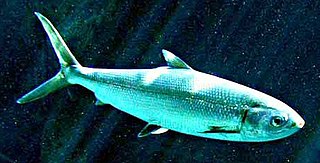
The Gonorynchiformes are an order of ray-finned fish that includes the important food source, the milkfish, and a number of lesser-known types, both marine and freshwater.

Chanidae is a family of fishes which has a number of fossil genera and one monotypic extant genus which contains the milkfish.
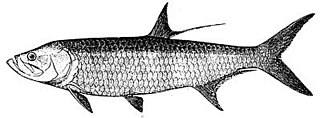
The Elopiformes are the order of ray-finned fish including the tarpons, tenpounders, and ladyfish, as well as a number of extinct types. They have a long fossil record, easily distinguished from other fishes by the presence of an additional set of bones in the throat.
Chondrostei is a group of non-neopterygian ray-finned fish. While the term originally referred to the paraphyletic grouping of all non-neopterygian ray-finned fish, it was redefined by Patterson in 1982 to be a clade comprising the Acipenseriformes and their extinct relatives.

Ostariophysi is the second-largest superorder of fish. Members of this superorder are called ostariophysians. This diverse group contains 10,758 species, about 28% of known fish species in the world and 68% of freshwater species, and are present on all continents except Antarctica. They have a number of common characteristics such as an alarm substance and a Weberian apparatus. Members of this group include fish important to people for food, sport, the aquarium industry, and research.
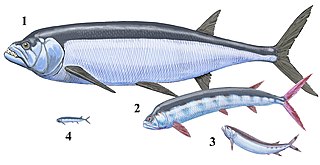
Ichthyodectiformes is an extinct order of marine stem-teleost ray-finned fish. The order is named after the genus Ichthyodectes, established by Edward Drinker Cope in 1870. Ichthyodectiforms are usually considered to be some of the closest relatives of the teleost crown group.
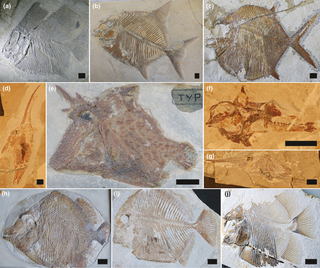
Pycnodontiformes is an extinct order of primarily marine bony fish. The group first appeared during the Late Triassic and disappeared during the Eocene. The group has been found in rock formations in Africa, Asia, Europe, North and South America. They were small to middle-sized fish, generally with laterally-compressed deep bodies, some with almost circular outlines, adapted for manuverability in reef-like environments, though the group was morphologically diverse. Most, but not all members of the groups had jaws with round and flattened teeth, well adapted to crush food items (durophagy), such as echinoderms, crustaceans and molluscs. Some pyncodontiformes developed piranha like teeth used for eating flesh. Most species inhabited shallow marine reef environments, while a handful of species lived in freshwater or brackish conditions. While rare during the Triassic and Early-Middle Jurassic, Pycnodontiformes became abundant and diverse during the Late Jurassic, exhibiting a high but relatively static diversity during the Early Cretaceous. At the beginning of the Late Cretaceous they reached their apex of morphological and species diversity, after which they began to gradually decline, with a more sudden decline at the end of the Cretaceous due to the collapse of reef ecosystems, finally becoming extinct during the Eocene. They are considered to belong to the Neopterygii, but their relationship to other members of that group is uncertain.

The Kneriidae are a small family of freshwater gonorhynchiform fishes native to sub-Saharan Africa.
Judeichthys is an extinct genus of prehistoric ray-finned fish that lived during the lower Cenomanian. There is one currently known species, Judeichthys haasi, which was found near Ramallah in Palestine.
Opsithrissops is an extinct genus of prehistoric bony fish that lived during the Thanetian stage of the Paleocene epoch. It is a 120 centimetres (3.9 ft) fish in the family Osteoglossiformes which includes other bony-tongues such as the extant species of arowana and arapaima.
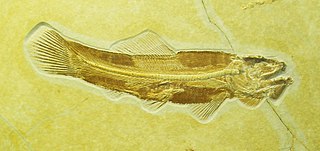
Amiopsis is an extinct genus of prehistoric bony fish belonging to the family Amiidae. Fossils are known from the Late Jurassic Solnhofen Limestone, Germany, the Early Cretaceous Purbeck Group, England, La Pedrera de Rúbies Formation, Spain and Bernnissant Iguanodon locality, Belgium and the Late Cretaceous (Cenomanian) of the Balkans. The monophyly of the genus is questionable, due to it being based on a single character, "the presence of three or more lateral fossae on each side of most abdominal centra". Remains previously assigned to this genus from the Early Cretaceous Las Hoyas, Spain have been moved into the new genus Hispanamia.
Coelodus is an extinct genus of fish in the family Pycnodontidae from the Late Cretaceous in Slovenia. This genus is wastebasket genus, various pycnodontiform fish remains are attributed to this genus, but only C. saturnus is valid.

Coccolepis is an extinct genus of prehistoric ray-finned fish in the family Coccolepididae. Originally including most species within the family, it is now restricted to two species from the Late Jurassic Solnhofen Limestone of Germany. The holotype of C. bucklandi, designated and described by Louis Agassiz, was thought to be lost but was later rediscovered in Neuchâtel.
Occithrissops is an extinct genus of prehistoric ray-finned fish of the Jurassic, described from Sundance Formation. The genus name of Occithrissops refers to the occidental occurrence of the genus and its relationship to Thrissops.
This list of fossil fishes described in 2017 is a list of new taxa of jawless vertebrates, placoderms, acanthodians, fossil cartilaginous fishes, bony fishes and other fishes of every kind that are scheduled to be described during the year 2017, as well as other significant discoveries and events related to paleontology of fishes that are scheduled to occur in the year 2017. The list only includes taxa at the level of genus or species.
This list of fossil fishes described in 2020 is a list of new taxa of jawless vertebrates, placoderms, acanthodians, fossil cartilaginous fishes, bony fishes, and other fishes of every kind that were described during the year 2020, as well as other significant discoveries and events related to paleoichthyology that occurred in 2020.
The Sainte-Barbe Clays Formation is a geological formation in Belgium. It is found in localised areas of the northern margin of the Mons Basin, alongside the equivalently aged Hautrage and Baudour Clay Formations. It is Upper Barremian-Lower Aptian in age. It predominantly consists of laminated clay, with some lignite. It is well known for the "Iguanodon sinkhole" locality near Bernissart where many specimens of Iguanodon bernissartensis were described by Louis Dollo in the late 19th century.

Tselfatiiformes is an extinct order of bony fishes from the infraclass Teleostei. The order represents the most important radiation of marine teleosts during the Cretaceous period. Fossils of tselfatiiforms are known from Europe, North America, central and northern South America, the Middle East and North Africa.

Coccolepididae is an extinct family of ray-finned fish, known from the Early Jurassic to Early Cretaceous, most of which were originally referred to the type genus Coccolepis. They had a widespread distribution, being found in North and South America, Australia, Asia and Europe. They are mostly known from freshwater environments, though several species have been found in marine environments. They are morphologically conservative, and have poorly ossified endo and exoskeletons, which usually results in poor preservation. This makes it difficult to distinguish species. They are generally small fish, with the largest known specimens reaching a length of 210 mm. Historically, they have been classified as members of “Palaeonisciformes”, a paraphyletic grouping of non-neopterygian fish, due to their plesiomorphic conservative morphology closely resembling those of many other groups of primitive fish. They have been suggested to be relatives of the Acipenseriformes within the Chondrostei.









